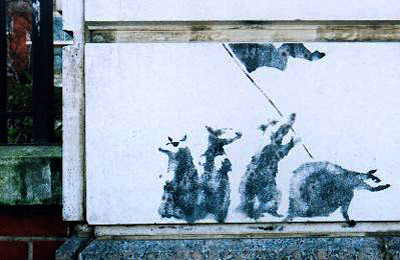Major Experience: My First Internship
Friday, August 27, 2010
Wrapup
Tuesday, July 27, 2010
The Great Rat Rebellion
 Today was the last day of maternal separations - and in keeping with Murphey's Law, nothing went smoothly. Both moms fought me as I snatched their babies. I almost forgot to inject two of the rats. Then, after I had completed the task at hand, all that remained was leaving them alone for four hours. I scurried off to begin some other projects for the day. Half an hour later, I returned to the "rat room" to organize some other cages. Just then, I caught some movement out of the corner of my eye. Something was not right. A white flash moved across my periphery. I looked closer - it was one of the baby rats. On the counter. Little Houdini had apparently escaped the incubator. I snatched him up and detained him back to his designated cup, only to realize that it was occupied by two other pups. Minor panic ensued. I nabbed the runaways and sorted them back into their cups, but the damage was done. Within five minutes, even the smaller ones were following suit and clamoring up the walls to freedom. While I could appreciate the humor of the situation, there was no way 16-day-old rats were going to keep me from successful completion of my mission. With some help from Boss, the problem was solved by covering the cups with weighted-down wire mesh. So I quelled the rebellion... for now.
Today was the last day of maternal separations - and in keeping with Murphey's Law, nothing went smoothly. Both moms fought me as I snatched their babies. I almost forgot to inject two of the rats. Then, after I had completed the task at hand, all that remained was leaving them alone for four hours. I scurried off to begin some other projects for the day. Half an hour later, I returned to the "rat room" to organize some other cages. Just then, I caught some movement out of the corner of my eye. Something was not right. A white flash moved across my periphery. I looked closer - it was one of the baby rats. On the counter. Little Houdini had apparently escaped the incubator. I snatched him up and detained him back to his designated cup, only to realize that it was occupied by two other pups. Minor panic ensued. I nabbed the runaways and sorted them back into their cups, but the damage was done. Within five minutes, even the smaller ones were following suit and clamoring up the walls to freedom. While I could appreciate the humor of the situation, there was no way 16-day-old rats were going to keep me from successful completion of my mission. With some help from Boss, the problem was solved by covering the cups with weighted-down wire mesh. So I quelled the rebellion... for now.
Monday, July 19, 2010
Another Monday...

The purpose of today's tasks are mostly to catch up...
Last week, I was assigned another Western Protocol. These are involved, multiple-day processes where detail orientation and a strict adherence to the guidelines are essential. Unfortunately, I managed to incorrectly complete Day 1, rendering Day 2's efforts useless. Boss says that I'm still within the learning curve, and that as a scientist she's used to disappointment. Translation? "GET IT RIGHT!" Today she's absent from the lab, so I'm 100% FOCUSED on making her proud. So far so good. We'll see how that turns out tomorrow...
Also, today I cleaned out all the rat cages. Some might consider this task inhumane... for those assigned to it. But I enjoy this opportunity to check on the baby rats, as well as a challenge to not lose any. Three of my litters are done with their maternal separations, and two more will be starting Wednesday. Two more litters are enclosed in a single cage, with both mothers. Because the litters are roughly 3 days apart in age, it creates an early life stress paradigm where older and younger "pups" are competing for attention and care. I was pleased to see that the younger pups have finally opened their eyes... rendering them much cuter and less developmentally impaired.
Got to run! The next step of my Western awaits!
McLean Hospital



Thursday, July 8, 2010
Informational Interview
Boss began by outlining her current research projects. She has hypothesized a model by which she predicts that abnormal serotonin levels in the brain at specific periods of development lead to a significantly higher risk of depression later in the child’s life. Boss is convinced that a circuit within the brain involving the Prefrontal Cortex, Dorsal Raphe Nucleus (serotonin release), and Basal Lateral Amygdala (anxiety mediation) may be the key to the development of depression. She has designed several modes by which to test this proposal, including behavioral as well as neurobiological procedures. Boss is hoping to establish a specific “sensitive period” to abuse during which children are most likely to develop depression, the onset of which is about nine years. With this knowledge, at-risk children can begin a regimen of medications before their symptoms even surface. I was impressed that Boss keeps future applications of her research in mind as she builds her theories.
I was surprised by the amount of writing, paperwork, and collaboration required for this field. Boss spends hours of every day preparing and reviewing grant applications. In order for her proposals to be accepted, she must conduct hours of preliminary research, ensuring that her ideas are concrete and worthwhile. With the funding she receives, Boss completes research to later be published in accredited journals such as Science and Developmental Neuroscience. Each paper must undergo the scrutiny of editors and reviewers, with many rewrites. Often, they request that Boss conduct additional research to augment her findings. I believe that the general public does not understand or appreciate the number of hours dedicated to publications outside the laboratory.
Though the interview did not stay exactly on-point with my predetermined questions, I found the ensuing conversation far more informative and motivational than I could have predicted. Boss has agreed to more frequent, informal, meetings of this kind. I am still undecided as to whether or not this is the career path that most suits me, but this interview clarified many questions I held regarding the responsibilities of the field.
Thursday, July 1, 2010
Research!

One of the mot amusing things about working in this lab is the strange dynamic between those currently working here (I say here because I'm currently writing in the lab... 5 more minutes until I need to transfer chemicals to the next step of the protocol...) It's run, like any independent trade from 18th century literature, by a Boss and her apprentices. Mine is an expert in her field, with many years of experience documented through tons of published works. However, she continues to grow and refine her techniques. She has two post-Doctorates, who conduct their own research, but still collaborate with the Boss frequently solicit for advice.
One of the post-Docs is currently conducting tests of early life stress on later working memory in rats. She creates early life stress by separating pups (baby rats) from their mothers for 4 hours/day. The effect will later be tested in a maze "wing shift," which will calculate the effectiveness of their working memory. (Our maze is an 8 arm radial maze like the one featured in the picture, though without all the doohickeys on top.)
The other post-Doc is conducting a "delayed discounting" task. Rats are trained to choose between one snack immediately, or four snacks if they can control their impulse.
My underling status is shared by another undergraduate from Holy Cross, and a recent graduate of Wheaton College. Holy Cross is testing rats given 6-hydroxy-dopamine, which decreases dopamine levels in the cortex, leading to ADHD behaviors. Wheaton is testing OCD (Obsessive Compulsive Disorder) behavior in rats, through demonstrations of anxiety, compulsive checking, etc. This is all mediated by D2 dopamine receptors! Woo science!
Details? Details.

Finally. Science!
My first two weeks working in the Developmental Psychopharmacology Lab at McLean Hospital, though mentally and physically taxing, absolutely flew by! For roughly 25 hours each week, I struggled to adjust to the lab and my boss's instructions.
Before I started, I had pictured myself working in one of two settings:
1. A sort of "mad scientist" dungeon-lair filled with specimens in jars, dangerous equipment, with only intermittent lightening strikes illuminating the room. Something similar to Ms. Moore's 9th grade biology class, complete with cases of taxidermied animals.
or
2. Something along the lines of scientific settings featured in commercials for facial cream or Botox. Sanitary white counters with CSI Miami-level technology complete with cool lighting effects. Everyone would wear lab coats and goggles. Tests would be finished by magic requiring little effort for instantaneous results.

I found reality somewhere in between. The lab is cluttered with ancient equipment, some covered in rust and dysfunctional. I would list them, but I honestly have no idea what they are. They rest next to modern counterparts: new pipettes, centerfuges, computers, and a shiny new stereotax (see picture above)! There are shelves of dusty books and binders, stained counter tops and sinks, and racks of chemicals. One of my favorite pieces of equipment is an impulse sealer (right), which we use to seal the edges of plastic bags.
I enjoy the excitement of various "dangerous" situations as well. Radioactive and biohazardous substances fill two refrigerators in the lab. Many chemicals may only be used under the ventilated "hood" with eye, mouth, and skin protection. It was in this setting that my adjustment to the research lifestyle began.
